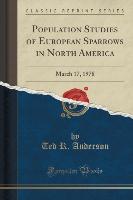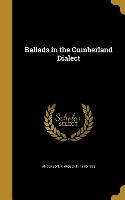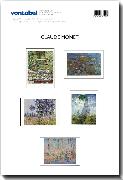Population Studies of European Sparrows in North America
BücherAngebote / Angebote:
Excerpt from Population Studies of European Sparrows in North America: March 17, 1978
Since that time it has persisted primarily in rural areas, and gradually has extended its range northward. It currently occupies a range of approximately 22, 015 km¿ (8, 500 mi¿) (Barlow 1973), extending about 160 km north from Saint Louis.
The purposes of this study were twofold: (1) to study the ecology of the tree sparrow in North America, and (2) to attempt to answer some of the questions raised by its very restricted range in North America. These questions can be stated in the following general form: (1) Are there competitive interactions between populations of the house sparrow and the tree sparrow in North America? (2) If so, what interactions may be involved in limiting the distribution of the tree sparrow? (3) If not, how are the two species partitioning their resource environment? To accomplish these objectives, I conducted concurrent population studies of the house sparrow and the tree sparrow and examined resource utilization patterns of the two species in areas of potential competition.
Several pieces of evidence suggest that the house sparrow might be involved in the restriction of the tree sparrow in North America. The similar ecologies of the two suggest the possibility of competitive interaction. Historical evidence also suggests the possible restrictive role of the house sparrow. In addition to the displacement of the tree sparrow from the Saint Louis urban area witnessed by Widmann, other similar events have been observed. On several of the smaller islands in the British Isles the tree sparrow was formerly a common resident, but disappeared after the house sparrow colonized the islands (Summers-Smith 1963). The wide distribution of the tree sparrow in Eurasia suggests that the species would not be limited on the North American continent by climate or other abiotic features of the environment. In addition, man has altered the environment of North America, particularly by clearance for agriculture, in much the same way as he did in Eurasia, and it is in this altered biotic community that the tree sparrow resides.
Population studies of both the house sparrow and the tree sparrow have been reported from Europe (Summers-Smith 1963, Pinowski 1968). Several studies on the breeding biology of the house sparrow in North America have been published (Weaver 1943, Will 1969, North 1972, Mitchell et al. 1973). Concurrent studies of the breeding biologies of both species have been conducted in England (Seel 1968a, b, 1969, 1970) and Poland (Mackowiez et al. 1970, Pinowski and Wieloch 1972). No study of the tree sparrow in North America has been reported, however (Barlow 1967).
Three areas of potential interaction between populations of house sparrows and tree sparrows in the utilization of resources were studied in an attempt to answer the questions posed above. Two of these areas involved potential competition for food, one during the winter, and the second during the breeding season.
About the Publisher
Forgotten Books publishes hundreds of thousands of rare and classic books. Find more at www.forgottenbooks.com
This book is a reproduction of an important historical work. Forgotten Books uses state-of-the-art technology to digitally reconstruct the work, preserving the original format whilst repairing imperfections present in the aged copy. In rare cases, an imperfection in the original, such as a blemish or missing page, may be replicated in our edition. We do, however, repair the vast majority of imperfections successfully, any imperfections that remain are intentionally left to preserve the state of such historical works.
Folgt in ca. 5 Arbeitstagen



